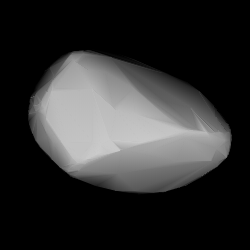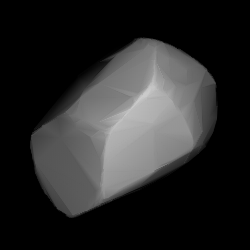Related Research Articles
4659 Roddenberry, provisional designation 1981 EP20, is a Nysian asteroid from the inner regions of the asteroid belt, approximately 3.6 kilometers (2.2 miles) in diameter. It was discovered on 2 March 1981, by American astronomer Schelte Bus at the Siding Spring Observatory in Australia. The likely S-type asteroid has an unsecured rotation period of 12 hours. It was named for American screenwriter Gene Roddenberry.
1826 Miller, provisional designation 1955 RC1, is a stony Eoan asteroid from the outer region of the asteroid belt, approximately 24 kilometers in diameter.
1047 Geisha, provisional designation 1924 TE, is a stony Florian asteroid from the inner regions of the asteroid belt, approximately 11 kilometers in diameter. It was discovered on 17 November 1924, by German astronomer Karl Reinmuth at the Heidelberg-Königstuhl State Observatory in southwest Germany. The asteroid was named after the British musical The Geisha.

1050 Meta, provisional designation 1925 RC, is a stony Eunomia asteroid from the central regions of the asteroid belt, approximately 10 kilometers in diameter. It was discovered on 14 September 1925, by German astronomer Karl Reinmuth at the Heidelberg Observatory in southwest Germany. The meaning of the asteroids's name is unknown. The presumably S-type asteroid has a rotation period of 6.14 hours and possibly an elongated shape.
1106 Cydonia, provisional designation 1929 CW, is a Eunomian asteroid from the central regions of the asteroid belt, approximately 13 kilometers in diameter. It was discovered on 5 February 1929, by astronomer Karl Reinmuth at the Heidelberg-Königstuhl State Observatory in Germany. The asteroid was named for the fruit-bearing tree Cydonia (quince). The S-type asteroid has a relatively short rotation period of 2.7 hours.

1160 Illyria, provisional designation 1929 RL, is a stony Maria asteroid from the central regions of the asteroid belt, approximately 13 kilometers in diameter. It was discovered on 9 September 1929, by German astronomer Karl Reinmuth at the Heidelberg Observatory in southwest Germany. The asteroid was named after the ancient region of Illyria, located on the Balkan Peninsula.
1168 Brandia, provisional designation 1930 QA, is a stony Eunomian asteroid from the central regions of the asteroid belt, approximately 10 kilometers in diameter. Discovered by astronomer Eugène Delporte at Uccle Observatory in 1930, the asteroid was later named after mathematician Eugène Brand.
1193 Africa, provisional designation 1931 HB, is a stony Eunomian asteroid from the central region of the asteroid belt, approximately 12 kilometers in diameter. It was discovered by South African astronomer Cyril Jackson at Johannesburg Observatory on 24 April 1931. The asteroid was named for the African continent.
21558 Alisonliu, provisional designation 1998 QW77, is a stony Eunomia asteroid from the middle region of the asteroid belt, approximately 8 kilometers in diameter. It was discovered on 24 August 1998, by the Lincoln Near-Earth Asteroid Research at the Lincoln Laboratory's Experimental Test Site in Socorro, New Mexico, United States. The asteroid was named for Alison Liu, a 2006 ISEF awardee.

1275 Cimbria is a Eunomia asteroid from the central regions of the asteroid belt, approximately 27 kilometers in diameter. It was discovered on 30 November 1932, by astronomer Karl Reinmuth at the Heidelberg-Königstuhl State Observatory in southern Germany. The asteroid was named after the Cimbri, an ancient Germanic tribe.
10830 Desforges, provisional designation 1993 UT6, is a background or Eunomian asteroid from the central regions of the asteroid belt, approximately 7 kilometers (4 miles) in diameter. It was discovered on 20 October 1993, by Belgian astronomer Eric Elst at the La Silla Observatory in northern Chile. The likely elongated S-type asteroid has a rotation period of 8.8 hours. It was named after French priest and aviation visionary Jacques Desforges.

2181 Fogelin is an Eunomia asteroid from the central regions of the asteroid belt, approximately 11 kilometers in diameter. It was discovered on 28 December 1942, by Germany astronomer Karl Reinmuth at the Heidelberg Observatory in southwest Germany. In 1980, it was named for Eric S. Fogelin an assistant at the Minor Planet Center. The likely elongated S-type asteroid has a rotation period of 14.07 hours.
3714 Kenrussell, provisional designation 1983 TT1, is a Eunomian asteroid from the central regions of the asteroid belt, approximately 10 kilometers (6 miles) in diameter. It was discovered on 12 October 1983, by American astronomer Edward Bowell at the Anderson Mesa Station near Flagstaff, Arizona, in the United States. It was named for Australian astronomer Kenneth S. Russell. The presumably stony asteroid has a rotation period of 5.25 hours.
1384 Kniertje, provisional designation 1934 RX, is a dark Adeonian asteroid from the central regions of the asteroid belt, approximately 26 kilometers in diameter. It was discovered on 9 September 1934, by Dutch astronomer Hendrik van Gent at the Union Observatory in Johannesburg, South Africa. The asteroid was named after a character in the Dutch play Op Hoop van Zegen by Herman Heijermans.
5542 Moffatt, provisional designation 1978 PT4, is a Marian asteroid from the central regions of the asteroid belt, approximately 9 kilometers (6 miles) in diameter. It was discovered on 6 August 1978, by astronomers at the Perth Observatory in Bickley, Australia. The likely S-type asteroid has a rotation period of 5.19 hours. It was named for Australian Ethelwin Moffatt, a benefactor of the discovering observatory.
1499 Pori, provisional designation 1938 UF, is a stony Eunomian asteroid from the central regions of the asteroid belt, approximately 15 kilometers in diameter. It was discovered on 16 October 1938, by Finnish astronomer Yrjö Väisälä at the Turku Observatory in southwest Finland. The asteroid was named after the Finnish city of Pori.

2384 Schulhof (prov. designation: 1943 EC1) is a mid-sized asteroid and the namesake of the Schulhof family, located in the Eunomian region of the intermediate asteroid belt. It was discovered on 2 March 1943, by French astronomer Marguerite Laugier at Nice Observatory in southeastern France. The asteroid was later named after Hungarian astronomer Lipót Schulhof. The presumed S-type asteroid has a short rotation period of 3.3 hours and measures approximately 12 kilometers (7.5 miles) in diameter.
3669 Vertinskij, provisional designation 1982 UO7, is a stony Florian asteroid from the inner regions of the asteroid belt, approximately 6.5 kilometers (4 miles) in diameter. It was discovered on 21 October 1982, by Soviet astronomer Lyudmila Karachkina at the Crimean Astrophysical Observatory in Nauchnij, on the Crimean peninsula. The S-type asteroid was named for Russian artist Alexander Vertinsky.
4085 Weir, provisional designation 1985 JR, is a stony Eunomian asteroid from the central regions of the asteroid belt, approximately 10 kilometers in diameter. It was discovered on 13 May 1985, by astronomer Carolyn Shoemaker at the Palomar Observatory in California, United States. The asteroid was named after American geologist Doris Blackman Weir.
7449 Döllen, provisional designation 1949 QL, is a stony Florian asteroid from the inner regions of the asteroid belt, approximately 3.5 kilometers in diameter. It was discovered on 21 August 1949, by German astronomer Karl Reinmuth at the Heidelberg Observatory in southwest Germany. The likely S-type asteroid has a rotation period of 10 hours. It was named after German astronomer Wilhelm Döllen.
References
- 1 2 3 4 5 6 7 "5855 Yukitsuna (1992 UO2)". Minor Planet Center. Retrieved 27 May 2018.
- 1 2 3 4 "JPL Small-Body Database Browser: 5855 Yukitsuna (1992 UO2)" (2018-04-26 last obs.). Jet Propulsion Laboratory . Retrieved 27 May 2018.
- 1 2 "Asteroid 5855 Yukitsuna". Small Bodies Data Ferret. Retrieved 27 May 2018.
- 1 2 3 4 5 6 7 8 9 "LCDB Data for (5855) Yukitsuna". Asteroid Lightcurve Database (LCDB). Retrieved 27 May 2018.
- 1 2 3 4 Mainzer, A.; Grav, T.; Masiero, J.; Hand, E.; Bauer, J.; Tholen, D.; et al. (November 2011). "NEOWISE Studies of Spectrophotometrically Classified Asteroids: Preliminary Results". The Astrophysical Journal. 741 (2): 25. arXiv: 1109.6407 . Bibcode:2011ApJ...741...90M. doi:10.1088/0004-637X/741/2/90. S2CID 118700974. (catalog)
- 1 2 3 Masiero, Joseph R.; Mainzer, A. K.; Grav, T.; Bauer, J. M.; Cutri, R. M.; Dailey, J.; et al. (November 2011). "Main Belt Asteroids with WISE/NEOWISE. I. Preliminary Albedos and Diameters". The Astrophysical Journal. 741 (2): 20. arXiv: 1109.4096 . Bibcode:2011ApJ...741...68M. doi:10.1088/0004-637X/741/2/68. S2CID 118745497.
- 1 2 Carbo, Landy; Kragh, Katherine; Krotz, Jonathan; Meiers, Andrew; Shaffer, Nelson; Torno, Steven; et al. (July 2009). "Asteroid Lightcurve Analysis at the Oakley Southern Sky Observatory and Oakley Observatory: 2008 September and October". The Minor Planet Bulletin. 36 (3): 91–94. Bibcode:2009MPBu...36...91C. ISSN 1052-8091.
- 1 2 Behrend, Raoul. "Asteroids and comets rotation curves – (5855) Yukitsuna". Geneva Observatory. Retrieved 27 May 2018.
- 1 2 Nesvorný, D.; Broz, M.; Carruba, V. (December 2014). "Identification and Dynamical Properties of Asteroid Families". Asteroids IV. pp. 297–321. arXiv: 1502.01628 . Bibcode:2015aste.book..297N. doi:10.2458/azu_uapress_9780816532131-ch016. ISBN 9780816532131. S2CID 119280014.
- ↑ "MPC/MPO/MPS Archive". Minor Planet Center. Retrieved 27 May 2018.